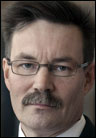Docrates Clinic, a private facility in Helsinki, Finland, that specializes in cancer diagnostics, treatment and follow-up care, is using a Wi-Fi-based real-time location system (RTLS) not only to locate staff members and patients, but also to allow communication between them. The system features RTLS software and RFID wristbands and badges from Ekahau, as well as a Wi-Fi network infrastructure provided by Cisco Systems. The clinic, which opened in May 2009, performs radiotherapy, chemotherapy and surgical procedures on as many as 600 patients annually, most of whom are seen as outpatients—though it also has seven beds for inpatients who typically stay for one or two nights. The clinic is growing, says Harri Puurunen, Docrates’ managing director, and intends to treat up to 1,400 cancer patients each year by 2013.
Though a health-care facility, Docrates Clinic tries to not always feel like one, Puurunen says. Patients are encouraged to stroll around the campus between procedures—or, for inpatients, to be up and out of bed when possible. What’s more, workers rarely sit behind desks, but rather walk about the site, tending to patients. Consequently, the clinic had sought a method for locating patients and letting them know when they need to meet with a medical practitioner, or undergo a procedure.
The hospital also sought a system that would enable visiting patients to reach members of its staff in the event of an emergency, and that would allow employees to communicate with each other when necessary. In addition, management wanted the staff to have the ability to see exactly where patients and workers were located at any given time.
When the clinic first opened, a nurse-calling system was installed in several departments. “This kind of wired system is fixed to limited locations,” Puurunen explains, “and we recognized the need to expand the system.” In fall 2009, the organization began looking into finding a wireless alternative that could cover the entire facility. “A person who needs first aid might be a patient in chemotherapy treatment, or a visitor in our conference room,” he says, “or, a radiographer in radiotherapy who needs additional help with a wheelchair patient. The system had to be flexible and easily configurable for future needs.”
Docrates chose a solution featuring Ekahau Wi-Fi battery-powered RFID transponders—specifically, T301W tags, which come in the form of patient wristbands, and T301BD badge tags, which are attached to lanyards that staff members can wear around their necks. The solution was installed over the course of about two weeks by systems integrator Vintor.
In the case of the wristbands, the tag transmits its unique identifier to Cisco Wi-Fi nodes throughout the facility as a patient moves about the campus. The nodes receive the ID number of that patient’s tag, then forward that ID to Ekahau standalone software running on the hospital’s server. The software links the ID number with the individual wearing the tag, as well as that person’s location, based on which Wi-Fi nodes had received the transmission.
A staff member wishing to locate a specific patient can input that individual’s name on a computer logged into the Ekahau application, and the system will then display a floor plan of the clinic, with an icon representing that patient’s location. A patient who needs to send a request for immediate assistance—for instance, if he or she has suddenly fallen during a visit—can press a single red button on the tag, thereby issuing an alert, along with the tag’s unique ID number. That data is received by the software and sent to the staff’s badges, which begin vibrating and flashing (LED lights are attached to the front of each badge). The badges’ text screen will then list the distressed patient’s name and location within the facility.
The employee badges come with four buttons, as well as a tab on the top that signals an emergency if pulled. In that case, an alert is sent to predetermined personnel indicating an emergency is taking place, along with the tag’s ID number. The four buttons can be used for a variety of purposes, determined by Docrates’ managers. Each button summons a specific group of personnel, as programmed into the software. If a wheelchair is needed, for example, a button could be pressed to summon the transport staff.
Each patient receives a wristband tag when admitted to the clinic, and then returns it upon leaving, at which point the link between the tag and that individual is deleted from the software so that the tag can be reused for a subsequent patient. If the tag leaves the facility (if, for instance, a patient attempts to exit the clinic prior to checking out, or forgets to remove it during check-out), the software determines that the tag is no longer being read and issues an alert to the appropriate employees.
“The communication element is what makes this application different,” says Tuomo Rutanen, Ekahau’s VP of business development. “Having location is great, but they wanted something more that would allow communication for both the patients and staff. I think the resulting solution is pretty powerful, all using the same wireless LAN network.”
In January 2011, the clinic intends to open what it calls a Well-being Center, consisting of another set of offices, at which it will provide further support services to cancer patients, such as massage, nutritional information, psychotherapy, wigs, pain treatments and peer groups. Docrates expects to install the Cisco wireless infrastructure and the Ekahau technology within the Well-being Center as well.
In the meantime, Puurunen says, the system has been popular with employees. “Our staff likes the freedom to move in the clinic [and still have communication capability],” he states. “You can call for help anytime and anywhere within the clinic, without delays. For patients, it gives a feeling of safety and professional care.”


